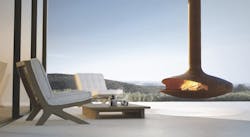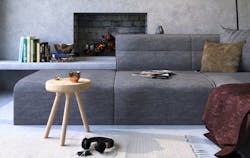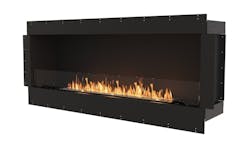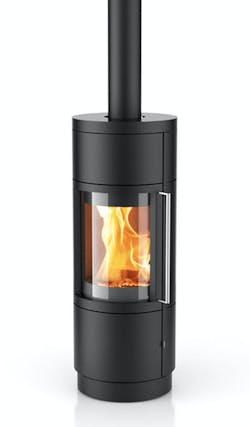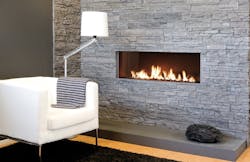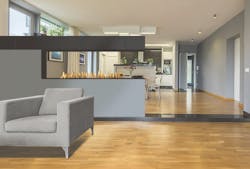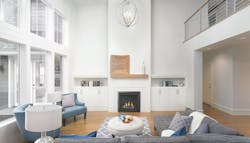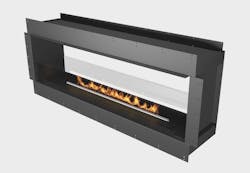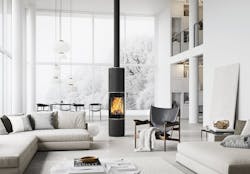In early America, fireplaces served as the hub of family life, providing fires for cooking and baking, as well as a warm place to gather, relax, read, and entertain. And the wood-burning fireplace was the primary source of a home’s heat.
In fact, according to U.S. Census Bureau survey statistics, as of 2010, 2.1% of all homes (2.4 million) burned wood as their primary heat source, up from 1.6% in 2000 (about 10% to 12% of American households when secondary heating is counted), with the increase primarily in rural areas.
And data from the U.S. Energy and Information Administration shows that wood’s popularity as a main heating source in homes in certain parts of the country (most notably the Northeast) saw its most significant recent increase from 2005 to 2012, the latest year for which federal figures are available. That uptick in the popularity of wood-burning fireplaces and wood pellet stoves for home heating can be attributed to the climbing cost of oil at the time, the economic downturn, and consumers moving to the use of renewable energy.
Changing Times for Fireplaces
But with a growing range of available home heating options, fireplaces are no longer the necessity they once were and national data show their overall decline in popularity (see below) over time, especially in the new-construction market. According to this data, the number of homes built with fireplaces remained relatively strong through the 1980s and ’90s, but the category has shrunk significantly since its high-water mark in 2005.
According to U.S. Census Bureau data for new single-family home completions:
- In 1978: 793,000 homes were built with one fireplace, and another 83,000 with two or more fireplaces (total: 876,000)
- In 2005: 818,000 with one fireplace, and another 83,000 with two or more fireplaces (total: 901,000)
- In 2010, 214,000 with one fireplace, and another 28,000 with two or more fireplaces (total: 242,000)
- In 2017: 320,000 with one fireplace, and another 38,000 with two or more fireplaces (total: 358,000)
The data shows a slight uptick in 2016 and 2017 to totals of 355,000 and 358,000, respectively, but more recent findings tabulated by the National Association of Home Builders (NAHB) from the Survey of Construction (produced by the Census Bureau with partial funding from HUD) show that just 41% of single-family homes started in 2018 included fireplaces—the lowest percentage on record since 2001 when the NAHB began consistently tabulating the data.
Fireplace Emissions and Air Quality
There are a variety of reasons for this decline, and it’s not simply because American consumers have tired of the fireplace’s nostalgic, cozy charm. Among them is the fact that since the introduction of the Clean Air Act in 1988, the Environmental Protection Agency (EPA) has continued to strengthen its clean air standards for residential wood heaters, tightening emissions guidelines in three stages, with a fourth stage in May 2020.
These guidelines also established what’s known as the New Source Performance Standards, which cover testing procedures and the exact test fuel and test circumstances required for each new appliance. Manufacturers had to adapt, and the strict regulations were a major blow to the wood stove industry.
As a result of these regulations, there has been a significant reduction of emissions and a shift toward increased use of gas-fueled appliances, which has seen emissions decrease even further.
But the regulations mean builders can no longer include non-EPA-certified hearth products in their homes, and that includes open-face wood-burning fireplaces. Additionally, some states, such as Arizona, parts of California, Colorado, Idaho, Maine, Oregon, Utah, and Washington have their own wood-burning laws that are even more stringent than the federal government’s.
RELATED
- For Better Indoor Air Quality: Build Tight and Ventilate Right
- EPA Final 2020 New Source Performance Standards for Residential Wood Heaters
- EPA Ordinances and Regulations for Wood-Burning Appliances
Fireplaces and Home Affordability
For home builders, “An obvious explanation for this [downward] trend is that builders are forgoing fireplaces in some of their homes so they can bring homes in at prices customers can afford,” the National Association of Home Builders wrote in a blog post in 2019. “Keeping new homes affordable has become a considerable challenge lately ... Fireplaces are generally a desirable amenity, but not one that all home buyers report as a must-have.”
A Variety of Fireplace Product Options
But all is not lost. For those builders that still want to offer hearth products in their homes, the industry has developed appealing alternatives to traditional wood-burning fireplaces. Gas products are popular options for many homeowners, with recent NAHB “What Home Buyers Really Want” surveys revealing that the share of prospective homebuyers that find gas fireplaces desirable or essential has increased since 2003, rising from 44% to 55% in 2018. And EPA-certified wood- and pellet-burning stoves, which are allowable options that provide a good source of heat for the home, are another option for consumers. For multifamily developers, a range of electric units are available that now offer far more realistic-looking flames than earlier models.
Take a look at the eight fireplace products below for hearth inspiration that makes use of the latest technologies for gains in efficiency and reduced emissions without sacrificing cozy hearth aesthetics.
8 New Fireplace Products
Wood-Burning Outdoor Fireplace
Gyrofocus by Focus Fires (lead image, above) is an outdoor fireplace with a suspended installation. Designed in 1968, the natural vent fireplace was first intended for the indoors but now comes in an outdoor version. Featuring a rotating hearth, the wood-burning unit is finished in a rust (shown) or black anti-corrosion paint.
Single-Room Fireplace
The Flex 68SS single-sided fireplace by EcoSmart Fire is specifically designed for a single-room application. Enabling the flame to be viewed from the front, the bioethanol, true zero-clearance fireplace can be used in a feature wall or integrated within cabinetry or a fireplace setting. The unit’s configuration and clean lines mean the entire viewing area is dedicated to the flame. The Flex 68SS features a linear flame and each burner holds 2.6 gallons of fuel, which can burn for up to 14 hours.
European Design Fireplace
The Bari stove is manufactured in Germany by Hase Kaminofenbau GmbH but features HearthStone’s TruHybrid combustion technology to bring a modern European EPA-certified hearth product to the North American market. Offering a 76% efficiency rating, the unit has two layers: an inner steel body that controls the stove’s combustion, and outer panels that finish the stove and create a convective air channel that circulates warm air through the home. Available in a variety of finishes.
Direct-Vent Gas Fireplace
The Modore 140 direct-vent gas fireplace from Element4 offers a 55-inch-wide viewing area and sleek design. Its unique media options include a log set, fire glass, white Carrara marble pebbles, or gray stones that sit directly in the flames. The unit features designer trim, improved tube-style burners, and the company’s E-Save Control System, which it says can save up to 45% on fuel consumption.
Vent-Free Gas Linear Fireplace
The H-Series vent-free gas linear fireplace from European Home features a trimless, open-front style and is designed with simplicity in mind, the manufacturer says. Because the unit is zero-clearance and vent-free, it’s easier to install and offers greater flexibility for fireplace location. The unit has a fuel efficiency rating near 99%, the company claims. The H-Series comes in three lengths: 42 inches, 60 inches, and 72 inches.
Traditional Gas Fireplace
The Altitude X Series traditional gas fireplace by Napoleon is available in two sizes and equipped with features to help make installation and customization a breeze, the company says. It offers eight fronts, six decorative brick panels, and four log set styles. Offering up to 38,000 Btu, it has a clean face design with full firebox flame, eFIRE remote app for control from a mobile device, and a heat-circulating blower.
Ventless Fireplace
The Forma Series by Planika USA is a bio-ethanol fireplace that features advanced burners and a zero-clearance firebox system. Available in 4-, 5-, and 6-foot sizes in six distinct styles—single-sided, see through, left and right corners, three-sided bay, and peninsula—the product provides a way for builders, designers, and architects to add a real-flame fireplace with no gas lines or venting. The unit can be controlled using a smart phone.
High-Efficiency Wood-Burning Fireplace
With a height of just over 75 inches, the Pilar fireplace from Rais has a modern Scandinavian sensibility and simple, sculptural design with views through the panoramic, rounded glass door. The wood-burning unit offers 90% efficiency, the company says, and can be specified with an optional manually operated air damper, CleverAir system, and ElectronicAir for remote control operation of the fireplace’s air supply.
